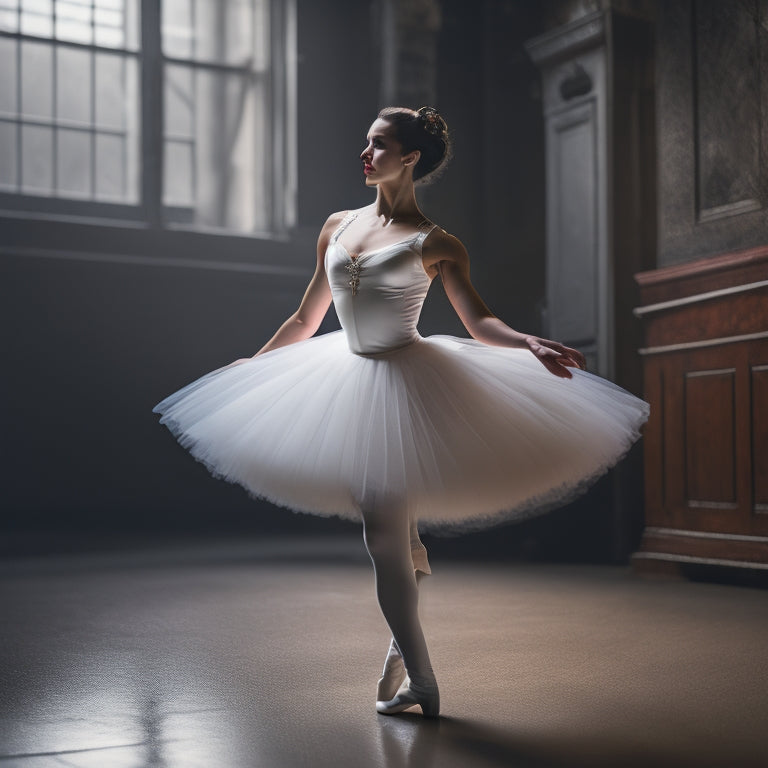
Do Ballet Dancers Suffer With Plantar Fasciitis?
Share
As a ballet dancer, you're prone to developing plantar fasciitis due to repetitive strains and stresses on your feet from constant movements, improper footwear, and biomechanical flaws. Your unique foot anatomy, muscle imbalances, and poor foot mechanics also contribute to the risk. High heels and pointe shoes worsen foot strain, and overuse, fatigue, and inadequate warm-ups/cool-downs exacerbate the issue. Weak core muscles and ankle instability further increase the risk. Now that you understand the factors contributing to plantar fasciitis, discover how to prevent and manage it to maintain your dancing career.
Key Takeaways
• Ballet dancers are prone to plantar fasciitis due to repetitive movements that stress the plantar fascia, leading to micro-tears and inflammation.
• Inherent biomechanical flaws, such as overpronation, can increase the risk of plantar fasciitis in ballet dancers.
• High heels and pointe shoes worsen foot strain, especially in the plantar fascia, and can contribute to the development of plantar fasciitis.
• Overuse and poor foot mechanics, including inadequate warm-up and cool-down, can contribute to plantar fasciitis in ballet dancers.
• Weak core and ankle instability can also increase the risk of plantar fasciitis in ballet dancers, highlighting the importance of core strengthening and ankle mobilization exercises.
The Impact of Repetitive Movement
Repetitive movements, inherent to ballet dancing, put excessive stress on your plantar fascia, a band of tissue connecting your heel bone to your toes, leading to micro-tears and inflammation.
As you repeat the same movements over and over, you're accumulating fatigue, which can lead to muscle imbalances. Your foot and ankle muscles work together to support your body, but when one muscle becomes fatigued, others must compensate, leading to further strain.
This fatigue accumulation and muscle imbalance can put additional stress on your plantar fascia, increasing the risk of plantar fasciitis.
Inherent Biomechanical Flaws
Your foot's unique anatomical structure, including a tendency towards overpronation or flat feet, can predispose you to plantar fasciitis due to the increased stress it places on your plantar fascia. This inherent biomechanical flaw can lead to abnormal pronation patterns, causing excessive strain on the plantar fascia.
Additionally, genetic predispositions can also play a role, making you more susceptible to plantar fasciitis. Muscle imbalances, such as tight calf muscles or weak ankle stabilizers, can further exacerbate the issue. These inherent flaws can predispose you to plantar fasciitis, making it essential to address them through proper training, exercises, and footwear choices.
High Heels and Pointe Shoes
When examining the role of high heels and pointe shoes in ballet, it's crucial to note that these shoes can worsen foot strain, especially in the plantar fascia.
The design of these shoes can add extra pressure on the heel and arch, causing increased stress on the plantar fascia.
It's imperative to take into account the implications of supportive shoe design in reducing this strain and minimizing the risk of plantar fasciitis.
Foot Strain Aggravation
Wearing high heels and pointe shoes can exacerbate foot strain, particularly in the plantar fascia, due to the constant pressure and elevated position of the heel. As you dance, the constant pressure on your heels can lead to micro-tears in the plantar fascia, causing inflammation and pain.
To alleviate this strain, try incorporating the following into your daily routine:
-
Use foot rollers to massage and stretch your plantar fascia.
-
Wear night splints to stretch your calf and foot muscles while you sleep.
-
Take regular breaks to stretch and flex your feet during long rehearsals.
- Consider incorporating exercises that strengthen your core and ankle muscles to reduce strain on your feet.
Supportive Shoe Design
Opt for high heels and pointe shoes with a supportive design that redistributes pressure, alleviating stress on the plantar fascia and mitigating the risk of strain. You'll benefit from shoes featuring arch support, which helps maintain the natural alignment of your foot and reduces tension on the plantar fascia.
Additionally, look for shoes with advanced cushioning technology, such as gel or foam inserts, that absorb shock and reduce impact on your heels. This combination of support and cushioning can notably decrease your risk of developing plantar fasciitis.
Overuse and Poor Foot Mechanics
You repetitively subject your feet to excessive stress and impact when you perform repetitive movements, leading to the development of plantar fasciitis. As a ballet dancer, you're prone to overuse, which can lead to fatigue factors that exacerbate plantar fasciitis.
Here are some key contributors to overuse and poor foot mechanics:
-
Inadequate warm-up and cool-down: Insufficient preparation and recovery can lead to excessive stress on your feet.
-
Abnormal arch types: Flat feet, high arches, or other unusual arch types can alter your gait and put additional pressure on your plantar fascia.
-
Poor foot mechanics: Abnormal pronation, supination, or other biomechanical issues can contribute to plantar fasciitis.
- Inadequate footwear: Wearing shoes that don't fit properly or provide sufficient support can increase your risk of developing plantar fasciitis.
Weak Core and Ankle Instability
When your core muscles are weak, they fail to provide adequate stability, allowing your ankles to compensate by rolling inward or outward, which can put additional stress on your plantar fascia. This instability can lead to poor alignment and excessive pronation or supination, further straining your plantar fascia.
To combat this, focus on core strengthening exercises that target your transverse abdominis and obliques. This will help improve your overall stability and reduce the stress on your plantar fascia.
Additionally, incorporate ankle mobilization exercises to improve your ankle's range of motion and reduce stiffness. By addressing your core weakness and ankle instability, you can reduce your risk of developing plantar fasciitis and maintain a healthy, pain-free dance career.
Inadequate Warm-Ups and Cooling Down
Do inadequate warm-ups and inadequate cool-downs set you up for plantar fasciitis?
As a ballet dancer, you know that rushing into a routine or neglecting proper cool-downs can lead to fatigue factors that increase your risk of developing plantar fasciitis. Here are 4 key reasons why:
-
Reduced flexibility: Inadequate warm-ups can leave your muscles and tendons stiff, making them more prone to injury.
-
Increased impact: Rushed routines can cause you to land incorrectly, putting excessive stress on your heels and plantar fascia.
-
Poor circulation: Inadequate cool-downs can impede blood flow, leading to inflammation and pain.
- Cumulative strain: Repeatedly neglecting proper warm-ups and cool-downs can lead to cumulative strain on your plantar fascia, increasing the likelihood of injury.
Prevention and Management Strategies
Implementing a combination of preventive exercises, stretching routines, and mindful technique adjustments can greatly reduce the risk of plantar fasciitis in ballet dancers.
You can start by incorporating mindful stretching exercises into your daily routine, focusing on calf and ankle mobilization. Additionally, make adjustments to your technique, avoiding overpronation and excessive rolling onto the ball of the foot.
Nightly massage can also help reduce tension in the plantar fascia. By incorporating these strategies, you'll be better equipped to prevent and manage plantar fasciitis.
Frequently Asked Questions
Can Orthotics or Shoe Inserts Help Alleviate Plantar Fasciitis Pain?
You're likely aware that 70% of people experience foot pain; now, can orthotics or shoe inserts alleviate plantar fasciitis pain? Yes, by providing arch support and correcting foot mechanics, they can greatly reduce discomfort and promote freedom from pain.
Are Ballet Dancers More Prone to Plantar Fasciitis Than Other Athletes?
You'll find that ballet dancers' high dance intensity and altered foot mechanics, characterized by pronated feet and excessive ankle rotation, increase their susceptibility to plantar fasciitis, making them more prone to this condition than other athletes.
Can Plantar Fasciitis Cause Long-Term Damage to the Feet?
As you navigate through life, you'll find that if left untreated, plantar fasciitis can cause long-term damage to your feet through altered foot mechanics, leading to chronic inflammation and potentially, permanent structural changes.
Do Ballet Dancers Typically Experience Plantar Fasciitis in Both Feet?
As you pirouette through life, you might wonder if ballet dancers typically experience plantar fasciitis in both feet. The answer is yes, bilateral symptoms are common, often due to foot dominance, where one foot bears more weight, leading to uneven stress and strain.
Is Plantar Fasciitis More Common in Professional or Amateur Ballet Dancers?
You'll find that plantar fasciitis is more common in professional ballet dancers, where high dance intensity and prolonged career longevity lead to increased repetitive stress and micro-trauma, exacerbating the condition.
Related Posts
-

Dance Wear Must-Haves for Elevated Performance
To raise your dance performance, prioritize wear that offers superior breathability and comfort. Look for moisture-wi...
-
Best Sustainable Athletic Wear Brands for Fitness
You deserve high-quality athletic wear that enhances your performance while being kind to the planet. Brands like Pat...
-

Unveiling Ballet: Insider Insights on Dance World
Ballet, an art form esteemed for its elegance and beauty, conceals a world of rigorous dedication, meticulous plannin...

